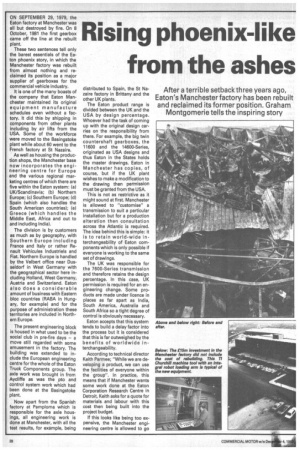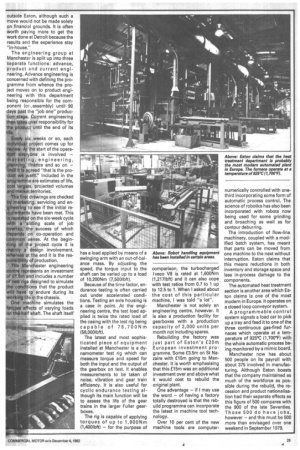Rising phoenix-like from the ashes
Page 24

Page 25

If you've noticed an error in this article please click here to report it so we can fix it.
After a terrible setback three years ago, Eaton's Manchester factory has been rebuilt and reclaimed its former position. Graham Montgomerie tells the inspiring story
ON SEPTEMBER 29, 1979, the Eaton factory at Manchester was all but destroyed by fire. On 8 October, 1981 the first gearbox came off the line at the rebuilt plant.
These two sentences tell only the barest essentials of the Eaton phoenix story, in which the Manchester factory was rebuilt from almost nothing and reclaimed its position as a major supplier of gearboxes for the commercial vehicle industry.
It is one of the many boasts of the company that Eaton Manchester maintained its original equipment manufacture schedules even without a factory. It did this by shipping in components from other plants including by air lifts from the USA. Some of the workforce were moved to the Basingstoke plant while about 60 went to the French factory at St Nazaire.
As well as housing the production shops, the Manchester base now incorporates the engineering centre for Europe and the various regional marketing centres of which there are five within the Eaton system: (a) UK/Scandinavia; (b) Northern Europe; (c) Southern Europe; (d) Spain (which also handles the South American countries); (e) Greece (which handles the Middle East, Africa and out to and including India).
The division is by customers as much as by geography, with Southern Europe including France and Italy or rather Renault Vehicules lndustriels and Fiat. Northern Europe is handled by the Velbert office near Dusseldorf in West Germany with the geographical sector here including Holland, West Germany, Austria and Switzerland. Eaton also does a considerable amount of business with Eastern bloc countries (RABA in Hungary, for example) and for the purpose of administration these territories are included in Northern Europe.
The present engineering block is housed in what used to be the social club in pre-fire days — a move still regarded with some amusement in the factory. The building was extended to include the European engineering centre for the whole of the Eaton Truck Components group. The axle work was brought in from Aycliffe as was the .pto and control system work which had been done at the Basingstoke plant.
Now apart from the Spanish factory at Pamploma which is responsible for the axle housings, all engineering work is done at Manchester, with all the test results, for example, being distributed to Spain, the St Nazaire factory in Brittany and the other UK plants.
The Eaton product range is divided between the UK and the USA by design percentage. Whoever had the task of coming up with the original design carries on the responsibility from there. For example, the big twin countershaft gearboxes, the 11600 and the 14600-Series, originated as USA designs and thus Eaton in the States holds the master drawings. Eaton in Manchester has copies, of course, but if the UK plant wishes to make a modification to the drawing then permission must be granted from the USA.
This is not as restrictive as it might sound at first. Manchester is allowed to "customise" a transmission to suit a particular installation but for a production alteration then consultation across the Atlantic is required. The idea behind this is simple: it is to retain world-wide interchangeability of Eaton components which is only possible if everyone is working to the same set of drawings.
The UK was responsible for the 7600-Series transmission and therefore retains the design percentage. In this case, UK permission is required for an engineering change. Some products are made under licence in places as far apart as India, South America, Australia and South Africa so a tight degree of control is obviously necessary.
Eaton accepts that this system tends to build a delay factor into the process but it is considered that this is far outweighed by the benefits of worldwide interchangeability.
According to technical director Keith Parmee; "While we are developing a product, we can use the facilities of everyone within the group". In practice, this means that if Manchester wants some work done at the Eaton Corporation Research Centre in Detroit, Keith asks for a quote for materials and labour with this cost then being built into the project budget.
If this looks like being too expensive, the Manchester engineering centre is allowed to go outside Eaton, although such a move would not be made solely on financial grounds. It is often worth paying more to get the work done at Detroit because the results and the experience stay "in-house."
The engineering group at Manchester is split up into three separate functions: advance, product and current engineering. Advance engineering is concerned with defining the programme from whence the project moves on to product engineering with this department being responsible for the component lor,assembly) until 90 days past the "job one" production stage. Current engineering then ta*ovei responsibility for the produce until the end of its life.
Every six .weeks or so, each
inclivid project comes up for review. the start of the opera tion one is involved — mark g, engineering, .planni ence and so on — until it reed "that is the pro duct ant." Included in the progr are estimates of life, cost ta , projected volumes and m. territories.
The drawings are checked by ma ng, servicing and en gineering to see if the initial re'iquirements have been met. This repeated on the six-week cycle with a sliding scale of job bverlap, the success of which Oepends on co-operation and eornmon sense. At the beginning of the project cycle it is mainly a design involvement, Vohereas at the end it is the responsibility of production.
The Manchester engineering cOntre represents an investment of £1.5m and includes a number of test rigs designed to simulate the conditions that the product will have to endure during its working life in the chassis. • One mach' ine simulates the feticide effects of varying loads on the-half shaft. The shaft itself has a load applied by means of a swinging arm with an out-of-balance mass. By adjusting the speed, the torque input to the shaft can be varied up to a load of 10,200Nm (7,500Ibft).
Because of the time factor, endurance testing is often carried out under accelerated conditions. Testing an axle housing is a case in point. At the engineering centre, the test load applied is twice the rated load of the casing with the test rig being capable of 7 8,7 0 0 Nm (58,000Ibft).
The latest and most sophisticated piece of equipment installed at Manchester is a dynamometer test rig which can measure torque and speed for both the input and the output of the gearbox on test. It enables measurements to be taken of noise, vibration and gear train efficiency. It is also useful for cyclic endurance testing although its main function will be to assess the life of the gear trains in the larger Fuller gearboxes.
The rig is capable of applying torques of up to 1,9 00Nm (1,400Ibft) — for the purpose of comparison, the turbocharged 1 veco V8 is rated at 1,600Nm (1,217Ibft) and it can also cope with test ratios from 0.7 to 1 up to 12.5 to 1. When I asked about the cost of this particular machine, I was told "a lot".
Manchester is not solely an engineering centre, however. It is also a production facility for gearboxes with a production capacity of 2,000 units per month not including spares.
Rebuilding the factory was just part of Eaton's £20m European investment programme. Some £3.5m on St NaZaire with £15m going to Manchester. It is worth emphasising that this £15m was an additional investment over and above what it would cost to rebuild the original plant.
One advantage — if I may use the word — of having a factory totally destroyed is that the rebuild programme can incorporate• the latest in machine tool technology.
Over 10 per cent of the new machine tools are computer numerically controlled with onethird incorporating some form of automatic process control. The science of robotics has also been incorporated with robots now being used for some grinding and broaching as well as for contour deburring.
The introduction of flow-line machinery, coupled with a mod ified batch system, has meant that parts can be moved from one machine to the next without interruption. Eaton claims that this means reductions in both inventory and storage space and less in-process damage to the components.
The automated heat treatment section is another area which Eaton claims is one of the most modern in Europe. It operates on a closed loop conveyor system.
A programmable control system signals a load car to pick up a tray and feed it to one of the three continuous gas-fired furnaces which operate at a temperature of 925°C (1,700°F) with the whole automatic process being monitored by a mimic board.
Manchester now has about 500 people on its payroll with about 375 involved in manufacturing. Although Eaton boasts that the company maintained as much of the workforce as possible during the rebuild, the recession and product nationalisation had their separate effects as this figure of 500 compares with the 900 of the late Seventies. Those 500 do have jobs, however — and this must be 500 more than envisaged over one weekend in September 1979.














































